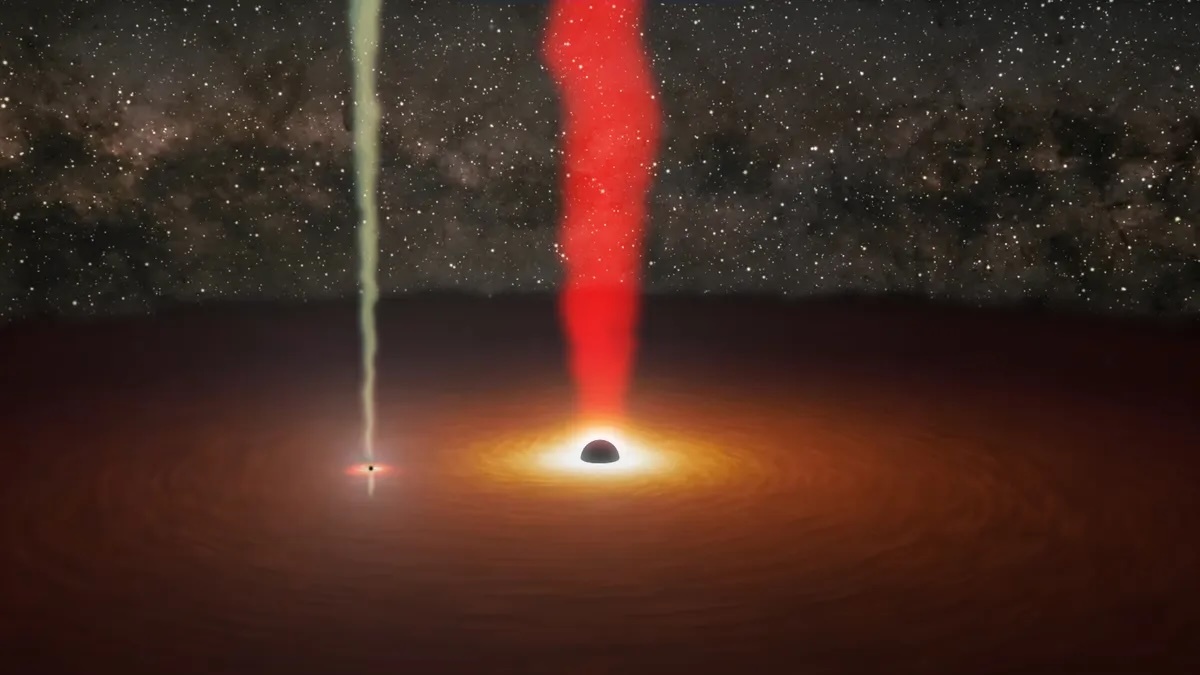19.06.2024
With the help of NASA's TESS spacecraft, astronomers have found a binary supermassive black hole system after the smaller of the black hole pair unleashed its quasar jet.

Artwork depicting the double quasar jets at the heart of the blazar galaxy OJ 287. (Image credit: NASA/JPL–Caltech/R. Hurt (IPAC) and M. Mugrauer (AIU Jena))
A binary black hole system in an active galaxy about 4 billion light-years away has been seen lighting up dramatically, when one of the black holes plowed through the accretion disk of the other, for a brief moment creating a double quasar.
A quasar is the extremely active core of a distant galaxy. This activity is the product of a supermassive black hole hungrily consuming matter, so much matter, in fact, that it can't handle all of it — instead, lots of material gets indiscriminately spat out in a magnetically collimated jet instead of falling beyond the black hole's event horizon like the rest of the matter. When we see such a jet of charged particles (which moves at almost the speed of light) head-on, the quasar looks especially bright. We call that a blazar.
The galaxy OJ 287, at a distance of about 4 billion light-years away, is one of the closest examples of a blazar. In fact, it is bright enough to be seen by large amateur telescopes, and there are observations of OJ 287 dating back to the late 1800s. Observations like these indicate that, every 12 years, OJ 287 seems to brighten. In 2014, Ph.D. student Pauli Pihajoki at the University of Turku in Finland proposed that this brightening was being caused by the presence of a second, less massive black hole orbiting and interacting with the primary black hole. If it so exists, the second black hole's orbit around the primary would be elongated, meaning it would only come close to the primary every 12 years.
As well as a general brightening of the system, Pihajoki reasoned that this interaction should also result in the smaller black hole stealing some matter from the large accretion disk of material around the primary black hole, and producing its own, smaller quasar jet for a short time. Pihajoki also predicted roughly when this would occur. So, in November of 2021, NASA'S Transiting Exoplanet Survey Satellite (TESS) was temporarily taken off exoplanet-hunting duties to scrutinize OJ 287. TESS was joined by NASA's Swift and Fermi gamma-ray telescopes, as well as a host of ground-based observatories, but it was TESS specifically that made the critical observations.
On Nov. 12, 2021, TESS detected OJ 287 brightening by about two magnitudes for about 12 hours, as it released as much energy in that short burst as 100 average galaxies would release in the same time. This flare was attributed to a jet from the second black hole; observations from the other telescopes supported that result as well, with Fermi in particular detecting a significant outburst of gamma rays.
"We can now say that wen have 'seen' an orbiting black hole for the first time, in the same way that we can say that TESS has seen planets orbiting other stars," said Mauri Valtonen of the University of Turku, who led the observations, in a statement.
The observations also allowed for the masses of the black holes to be confirmed. The primary black hole — aka, the main source of energy in OJ 287 — is a whopping 18.35 billion solar masses, while the secondary is no lightweight, with 150 million solar masses. In comparison, Sagittarius A*, which is the black hole at the center of our Milky Way galaxy, has a mass of only 4.1 million solar masses.
The short amount of time during which the flare was active explains why neither it, nor flares from other binary black hole systems, hadn't been discovered until now. Knowing when and where to look to see such flares is crucial, and there could be many other binary black holes experiencing similar flares that we don't know about. However, those black hole binaries may soon have nowhere to hide.
"The smaller black hole may soon reveal its existence in other ways, as it is expected to emit nano-Hertz gravitational waves," Achamveedu Gopakumar of the Tata Institute of Fundamental Research in India, who participated in the observations, said in the statement. "The gravitational waves of OJ 287 should be detectable in the coming years by the maturing pulsar timing arrays."
Pulsar timing arrays work by constantly orbiting a network of pulsars out in deep space. Pulsars are spinning neutron stars that emit radio jets like cosmic lighthouses. We can measure how fast they are spinning by counting how frequently we see their radio jets rotate in our direction. Some pulsars can spin hundreds of times a second, leading to them appearing to pulse in radio waves as their jets repeatedly flash at us.
Notably, pulsars keep time very well, with their periods of pulsation being unerringly accurate. However, should gravitational waves ripple past, they'd distort the space between us and the pulsar, which would affect our perspective of the timing of these pulses
Binary black holes are also important for the growth of supermassive black holes. Recent results presented at the 244th meeting of the American Astronomical Society this June in Wisconsin showed that mergers between supermassive black holes are an important secondary factor in their enormous growth, and when they do spiral towards one another in the process of merging they release ripples of gravitational waves. Although these gravitational waves are too low in frequency for LIGO, the Laser Interferometer Gravitational-wave Observatory to detect, a proposed space-based detector called LISA, the Laser Interferometer Space Antenna, would be able to detect their coalescences as they come together in major cosmic crashes.
The results of the observations of OJ 287 were published on June 11 in The Astrophysical Journal.
Quelle: SC
